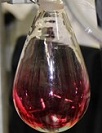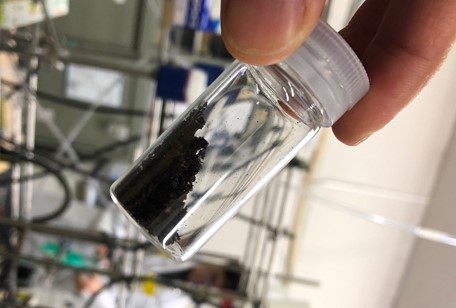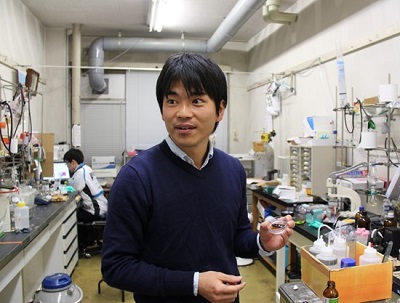TSUKUBA FUTURE
#103 Realizing the Potential of Materials
Associate Professor KUWABARA Junpei, Faculty of Pure and Applied Sciences

Solar cells are representative of natural energy sources, and their practical application is advancing in areas from home use to mega-solar power facilities. However, because they use hard and heavy inorganic materials such as silicon, they are not well-suited to transport or to machining into shapes other than flat surfaces. For these reasons, organic solar cells using lightweight, flexible polymer materials are attracting attention. If such materials can be utilized to their full capacity, new applications for solar cells may appear.

Solar cells convert the light energy of the sun into electrical energy. It would be ideal if all the light from the sun could be converted into electricity, but at present the maximum conversion efficiency is about 40% or so, and this is achieved using inorganic materials such as silicon. Inorganic materials are not easily degraded and can withstand outdoor use for decades, and so are suited to power generation at places where permanent large-area installation is possible, such as the roofs of homes and mega-solar power facilities; but their hardness and weight are drawbacks. They are ill-suited to applications in which they are machined into curved surfaces and mounted on vehicle roofs, for example, nor are they easily transported as mobile battery devices.
Prof. Kuwabara's research theme is solar cells formed from organic polymer materials (plastics). Polymer materials have the advantages of being lightweight and easily formed into films and various other shapes. There is competition in numerous laboratories around the world to develop organic solar cells, but the most important goal of this research is to raise the energy conversion efficiency. Diverse polymer materials are being explored, and in recent years some have shown an energy conversion efficiency of 14% or so. Even so, this lags far behind the efficiency of inorganic materials, and there are also problems with commercialization due to the difficulty of large-scale synthesis.
While continuing to keep an eye on this research competition, Prof. Kuwabara's approach is to attempt to develop methods for synthesizing compounds that have already been discovered so as to yield still higher efficiencies. The molecular structures and characteristics that are suitable for solar cells can, to some extent, be predicted through theoretical calculations. However, actually synthesizing them is another matter entirely. The basic structure that these compounds have in common is a series of alternating single and double bonds between carbon atoms, called a conjugated polymer. However, when the desired characteristics are incorporated, the molecular structure quickly becomes highly complicated, and synthesis requires processes spanning many stages. In order to avoid generation of byproducts and achieve more of the targeted compound, the method of synthesis must be as simple as possible.
As one simple method of forming carbon-carbon bonds, "cross-coupling reactions" such as the one that was the basis for a Nobel Prize in 2010 are famous. However, because starting materials that include metal atoms such as tin and boron are used, some troublesome synthesis processes are included, and the generation of byproducts cannot be avoided. Here Prof. Kuwabara engaged in research on catalysts for similar reactions without using tin or boron, and searched for reaction conditions adequate to induce the reaction, and finally succeeded in developing an original synthesis method. The targeted compound is synthesized from substances that are easily obtained, in a first-rate method that produces only harmless byproducts that can easily be separated.
Moreover, the reaction efficiency for this method is higher than for conventional cross-coupling reactions, and the molecular weight of the polymer compounds obtained is far greater. Polymer compounds consist of strings of basic unit structures, but the properties of the substance differ depending on how many of the unit structures are connected, or whether they are connected in straight-line fashion or with branching. As solar cell materials, polymers with longer straight-line chains exhibit superior characteristics. Moreover, in Prof. Kuwabara's method, byproducts can easily be separated and polymers of high purity are obtained, so it has become possible to provide high-quality materials. And in fact, whereas the energy conversion efficiency of polymers synthesized by conventional methods is about 0.5% or so, the polymers synthesized by Prof. Kuwabara and his colleagues have exhibited a high conversion efficiency of 4%. This new discovery, in which the intrinsic potential of the material is elicited by further increasing the molecular weight and improving purity, has reverberated among researchers both in Japan and abroad.
Organic solar cells, rather than replacing existing inorganic solar cells, are expected to excel in other applications where flexibility and mobility are sought. For example, they hold promise as devices incorporated into bags to charge smartphones and personal computers on the road, or as the power supplies for sensors when controlling appliances in the home, or as emergency power sources. There are many areas of our lives that would benefit from such sources of small amounts of power, even if conversion efficiencies are somewhat low.
It was while in graduate school that Prof. Kuwabara became interested in chemical synthesis. He says he got hooked on the joy he experienced the first time he succeeded in producing a substance that only he could create. Upon arriving at the University of Tsukuba, he decided he wanted to utilize past knowledge and experience in the synthesis of polymers, and set his sights on solar cells, demand for which was then on the rise. Until that time he had not been particularly interested in solar cells, but upon embarking on his research, he obtained satisfactory results for compounds he synthesized properly--that is, the research team acquired some skill in synthesizing compounds and began to question the true value of settings for reaction conditions, and these things served as motivation. There are many diverse research organizations and companies in close proximity in the city of Tsukuba, and the ability to exchange ideas and easily obtain cooperation is attractive to a researcher. Prof. Kuwabara is searching for a new research theme that matches his interests while continuing to pursue the potential of polymer materials.

The newly developed organic material for solar cells. Because it absorbs nearly all light in the visible range, it is black, and it can absorb sunlight over a broad spectral range.

An organic material now being newly developed, separately from solar cell materials, that uses algae oil as a starting material. It is expected to find uses as a battery material.
Article by Science Communicator at the Office of Public Relations


